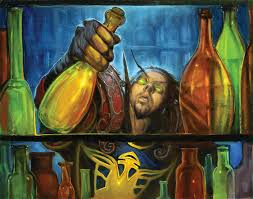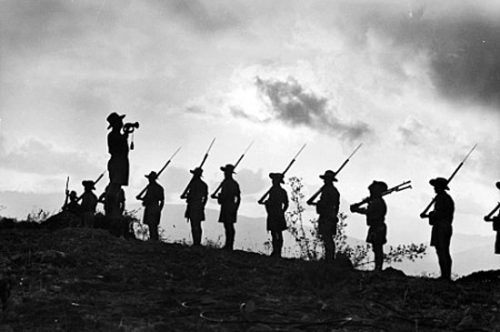
My life has been divided into four nine-year blocks that correspond to the four masculine elements of clay, iron, silver and gold. This has culminated in my own apotheosis as someone who no longer fears the death of the physical body. Such thoughts became apparent to me when I marked the occasion of having been around the Sun thirty-six times, and reflected upon the wobbly path that was taken.
The phase of clay, representing the first nine years, was when simple survival skills were learned. This phase is shared by all creatures that need to survive, right down to the dumbest herbivore. This is the phase that we are born into, one that is characterised by fear as we learn to balance our innate curiosity with staying away from dangers.
In the first nine years of my life I was little different to a sheep or chicken. Essentially all actions I took were reactions. Usually I was guided along by well-meaning adults, and usually I had no reason to not comply. In this phase a basic civilising process took place, and I learned to enjoy life.
The alchemical culmination of this phase is tin, which corresponds to the planet Jupiter. Like Jupiter, it is large, larger-than-life in some ways. It’s bombastic and narcissistic but it is grounded in a healthy affirmation of life and therefore is necessary before the next phase can begin.
The iron phase began when I learned to take competitive sport seriously. Here the enjoyment of life becomes strong enough that a desire to challenge oneself and others arises. This happened at about the same time as puberty began, and with that came a desire to kill other males.
This is the phase when it becomes useful for a child to learn a martial art, or when it becomes enjoyable to seriously develop a set of skills for a competitive sport. Fittingly for iron, during this phase I became a harder individual, but in becoming so I also became a more useful one, in the same way that tools of iron are much more useful than tools of clay.
Its apogee was an incident on a rugby field where I hit an opposing ball carrier so hard in a tackle that I broke my own collarbone on impact and was knocked to the ground. He and I had developed a grudge over the course of the game, hitting each other harder and harder in tackles to try to show off who was strongest. I was about 15kg lighter than him and resorted to a shouldercharge to make up for it.
Unfortunately, he saw he coming and put the shoulder in himself, and I came off second-best (in an odd coincidence, that player, Simon P. Murphy, went on to become the author of His Master’s Wretched Organ, published by this company!).
The incident taught me to appreciate the limits of the sphere of iron. It was effectively where I learned the limitations of aggression and violence, and that knowing how to guide aggression intelligently was much more important than sheer volume of aggression.
It represented a softening to something of greater value, and this was represented alchemically by the phase of silver. This was also where I learned the value of intelligence. On the rugby field it didn’t seem like intelligence was worth much, as it appeared to me mostly about strength. But knowing how to direct one’s strength, not strength itself, was the real ability of value.
This phase began around age 18 and involved going to university. At university it is expected that one has gotten over the testosterone-fueled dominance battling of the phase of iron and therefore that one can work on polishing oneself up.
For me, embarking on the path of silver began with a Bachelor’s degree in psychology, and with losing my virginity to a Swedish nursing student. Upon managing both of these things I developed an appreciation for what intelligence had to offer the world.
I learned to use my own intelligence to go travelling and work around the world, spending three years in Europe and a year in other foreign climes. During this time I learned a few languages, and upgraded my education to a Master’s degree, and by the end of this nine-year block I was capable of thinking logically and rationally.
Being able to think intelligently is an ability that dazzles those still on the level of iron or clay, and as such it corresponds to the reflective ability of sunlight off a mirror. But intelligence itself is not, by itself, necessarily an expression of the will of God.
The silver became, in itself, more alive, and this moved me into the realm of mercury. This was represented in the material world by doing a lot of bar work. Here I learned to become silver-tongued, and to crack jokes, and to parry insults into harmless banter, and to be glib and slick and easygoing.
Seven grams of psilocybin mushrooms, taken shortly after I turned 27, marked the end of this phase of silver and mercury. These I had been given by a hippie workmate upon expressing to him what I felt to be the mental health benefits of smoking cannabis, especially for someone like me who had long suffered problems from nausea and insomnia.
I recall, at the peak of the trip, standing before God and being asked how much I thought I could handle, and replying that I wanted the full measure. In that moment I became entirely reunited with God and understood that I was forgiven for all errors, past and future.
This experience obliterated my mind, and taught me that everything I knew was wrong. I had been granted a glimpse into the face of the divine, but because of my ego and attachment to false self I was not immediately able to manifest the knowledge that I had been granted in my everyday life.
I had two options: to abandon the shamanic path and dismiss the insights gleaned from psychedelics as delusions and insanities, or to accept the challenge of the phase of gold.
I accepted the challenge of the phase of gold, and this involved a willful refusal to allow myself to forget the insights that I had been granted at the peak of the mushroom trips, such as an insight into the true nature of consciousness, or the fact that the contents of consciousness could be represented as a Great Fractal.
The culmination of this phase was writing a manuscript called The Pyrrhonist, an exercise in questioning reality from first principles. This caused the complete disintegration of my entire personality and of everything I believed to be real. I systematically questioned every belief I had, even the most fundamental, and by the end of that process I had questioned the fundamentals of reality so thoroughly that I was mad.
At the nadir of this phase I spent ten days in a mental health unit.
This dark night of the soul served as an nitric acid, dissolving all of the less pure elements of my soul; I was completely humbled. I was forced to stand before the judgment of God and concede that the maintenance and preservation of my ego was a fool’s errand – not only did I make myself less happy, but everyone who encountered me got less out of it than they otherwise would have done.
At this point I had been completely broken, and was ready to rebuild.
This took another three years or so, and involved a kind of self-nurture that, ironically, I had been too selfish to previously allow myself, lest the softness made me weak. It also involved smoking a tremendous amount of cannabis, for the reason that this medicine prevented the pull of the body from dragging my frequency back down to clay because of pain and nausea.
I had to learn to accept that I was not and could never be judged by ephemeral concerns. I embarked on an attempt to purify my soul, which involved abstinence from all of tobacco, alcohol and women.
This last of the four nine-year blocks of my life ended this week, upon turning 36. It ended with my acceptance of the fact that I feel entirely at peace and that there is nothing, fundamentally to fear. I am absolved of all sin and can take my part in the play.
This, I feel, is the lesson of the element of gold. It cannot shine directly on people, in the manner of silver, because where people become blinded and dazzled by silver they become humbled by gold, and in being humbled they become resentful, and in becoming resentful they become destructive.
Gold, being the softest of all metals, can least tolerate that destructive will, and so it has to learn to be subtle. Its essence is therefore gentleness and precision. Working on the level of gold means learning to influence on the level of spirit, not just the level of mind (as is silver).
I feel that now, at age 36, a certain alchemical process has come to its end and that now I can live on whatever level of clay, iron, silver or gold is necessary for the environment that I am in, now that I know how to tune into the appropriate frequency.





